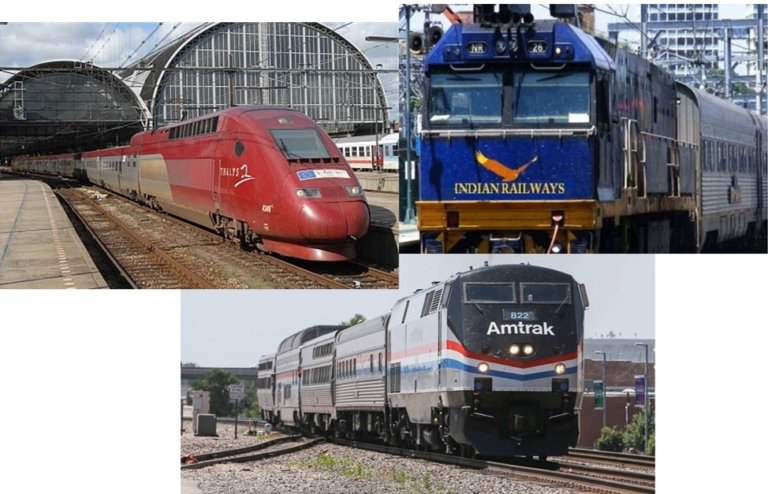by Conall Mac Aongusa, Transport Planner, member of RailHow Team, 23/07/2019
Travel for some people is a daily grind or a long commuter struggle, for others it is an adventure opening up possibilities, horizons and new landscapes. Travel can be a different experience for everyone at different times and in different circumstances. However, a transfer is generally an unwanted interruption of a journey which impacts on the travel experience – therefore a transport interchange, whether it’s a railway station or a bus or metro station has the possibility to improve or frustrate your entire journey and travel experience.
So what makes a good interchange and what makes our experience a pleasant one rather than a frustrating one? And what can owners, operators and planners do to make this experience better?
From a customer or traveller point of view, large interchanges have become places where many more activities take place than people just transferring between modes and waiting for public transport. People meet, do business, work and shop at interchanges. Travellers have different priorities depending on their age, their purpose of travel and chosen mode of travel. Those with mobility impairments may have priorities which are additional or different to other travellers. Ease of mobility and movement is important to people with disabilities, children or who have luggage, whilst facilities at the interchange, such as car parking, and routes to and from interchanges, for walking and cycling are important for people who wish to use the interchange on a regular basis.
There are also differences in needs between users and non-users (i.e. potential users) of interchanges, and between men and women. At interchanges travellers usually need to wait and spend time. When services are offered, or shops are located at the interchange the quality of the time to spent waiting may improve. Comfort is currently a very important element of a trip, as is the perception of security and reliability and the provision of clear timely consistent information about the services and direction locations. This leads to several additional services at public transport interchanges besides the transport function itself.
The main aspects that are important to most users of transport interchanges are the perceived time and cost. However, travellers do not perceive time as having the same value throughout a journey, for example, some people regard time spent waiting as equivalent to a longer period of time spent on the move. One of the main factors that can determining whether people are likely to use an interchange is accessibility in terms of both physical facilities and information about their multimodal journey.
The management and operation of a transport interchange can be done in accordance with different models but in essence there are two ways – one is known as the “airport model” where one organisation manages the entire interchange area and the transport operators including train and bus companies provide the transport services. The other common model is that the transport operator owns and manages the interchange terminal as well as providing the transport services. Transport operators therefore have different responsibilities in different interchanges.
As transport operators are among the most important stakeholders in interchanges, they are usually involved from the very beginning when it comes to interchange planning and design. Transport operators focus on the satisfaction of the interchange passengers (e.g. harmonised schedules of all modes to shorten travel times), taking however into consideration the legal restrictions, societal requirements (well-being of passengers and sustainability of the interchange), the local politics and the cost effectiveness.
Effective planning, management and operation of transport interchanges are essential to realising the benefits for both travellers and operators. Important operations include considerations of service coordination, operating costs integrated ticketing, maintenance, safety and servicing. Station managers and transport operators are primarily assessed on their service performance, customer satisfaction and patronage levels. Depending on whether it is a commercial organisation, they will seek to optimise revenues while minimising operational costs.
From a planner and policy maker’s point of view transport interchanges are an important element in facilitating seamless travel and intermodal transfers, and are crucial to the quality of the public transport system at the local, regional or national level. Providing efficient interchanges that are safe, accessible, and sustainable in operation and design should be an objective for all governments. The question that arises is how can governments realise this, and how can they develop a policy framework where successful, cooperative multimodal transport operations can take place. This can be difficult in a situation where public and private stakeholders are involved who each have different interests.
Having clear objectives for the management of the transport interchange can go a long way to meeting government transport goals. Safe and sustainable design of interchanges can make them work more efficiently, mitigate against climate change, improve security, add value to an interchange, enhance the business case and meet with the needs of people who want to use the interchange now and in the future.
A crucial element in providing successful multi modal interchanges is understanding the requirements of the users, both existing and potential travellers. Transport operators use interchanges, and are in many cases involved in/or responsible for their management and operation.
Planners and policy makers aim for more sustainable urban transport in the future and a focus on interchanges can impact transport demand as they are considered an important element in the transport networks.
The perfect interchange probably does not exist. It should ideally include all elements that the different stakeholders consider to be important.


